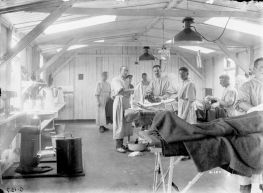 It is 100 years since the notorious battle of Passchendaele. We now know much more about the trauma experienced by thousands of troops during the Great War and we recognise that, even into the 21st-century, service personnel can be affected by combat stress and post-traumatic stress disorder on the battlefield, and for many years after their involvement. Sadly, there is still insufficient support for those affected, and it is still difficult for men and women to come forward and talk about their symptoms, admitting fragility in such a tough environment.
It is 100 years since the notorious battle of Passchendaele. We now know much more about the trauma experienced by thousands of troops during the Great War and we recognise that, even into the 21st-century, service personnel can be affected by combat stress and post-traumatic stress disorder on the battlefield, and for many years after their involvement. Sadly, there is still insufficient support for those affected, and it is still difficult for men and women to come forward and talk about their symptoms, admitting fragility in such a tough environment.
Just before the battle we now refer to as Passchendaele (or the Third battle of Ypres) – fought between July and November 2017 and perhaps the most bloody and futile of the First World War – the War Office was becoming concerned at the sheer number of men breaking down with what was commonly known as ‘shell shock’. So General Haig’s adjutant, Lt Gen. Fowke, issued ‘General Routine Order 2384’, stating that diagnoses of mental disorder were not to be made on the battlefield, instead requiring several days of observation by doctors close to the Front.
So during the Battle of Passchendaele, a tougher approach was taken. It was thought then that ‘suggestion’ could reinforce symptoms and that evacuation to a specialist hospital, or back to Britain should be a very last resort. The aim was to get a man back to the trenches – using what was referred to as ‘discipline and forceful encouragement’, and there was more prolific use of alcohol, which, they believed, made mental collapse less likely and prevent the retention of traumatic memories.

Men who showed symptoms of shell shock were offered time away from the battlefield. Evacuation to a specialist hospital was not to be considered until a man had spent a number of weeks under observation, in (slightly greater) comfort with the opportunity for sleep and better food rations, at a Clearing Station within ear-shot of the trenches. Their duty to their fellows in the trenches and their love of their country was reinforced and the majority did return to the front line, encouraging doctors to consider this tougher approach a success. The 1922 Committee on Shell Shock heard evidence that only 16% of cases had to be referred to specialist hospitals, and 10% were returned to England. Just 10% of men returned to active duty, it was claimed, relapsed once and 3% more than once.
Post war there was little written on this subject by the doctors involved, and younger, more progressive doctors and psychiatrists (who were not involved in the strategy and who would undoubtedly have questioned the methods) were horrified at any suggestion that leaving a fragile man amongst his peers could lead to some form of ‘infection’ with shell shock.
But during that terrible battle, and until the end of the war, the most important factor in the treatment of shell shock was to deal with the numbers – there was an acute shortage of trained men and every available chap was needed to fight for his country. Their post-war suffering was not the first concern. In fact, it was a real worry, as politicians struggled with the amount they feared would need to be paid out in pensions for those most seriously affected.
One thing that always strikes us about those who survived the war is their silence, their reluctance to talk about their experiences. For many years, this was seen as bravery, the stiff upper lip of the British Tommy and many of the men returning to their families coped well. But we now know that not to speak of trauma, to repress it, can be deeply harmful. Levels of alcoholism, criminal activity, domestic violence and family breakdown are still higher amongst veterans even 100 years later. Giving men a break from the horror, a stiff drink and the opportunity to sleep may have helped a few, but it left many scarred for life, whether or not they ever ‘relapsed’ in the sense expressed to the committee in 1922.
The treatment of shell shock during the Great War, and the consequences for men and their families, for society as a whole and those affected in subsequent conflicts are something I researched at length for Shell Shocked Britain: The First World War’s legacy for Britain’s mental health, and as we move into the last eighteen months of the commemorative period I believe it is desperately important that this legacy is not lost as 100 years since the Armistice approaches.


